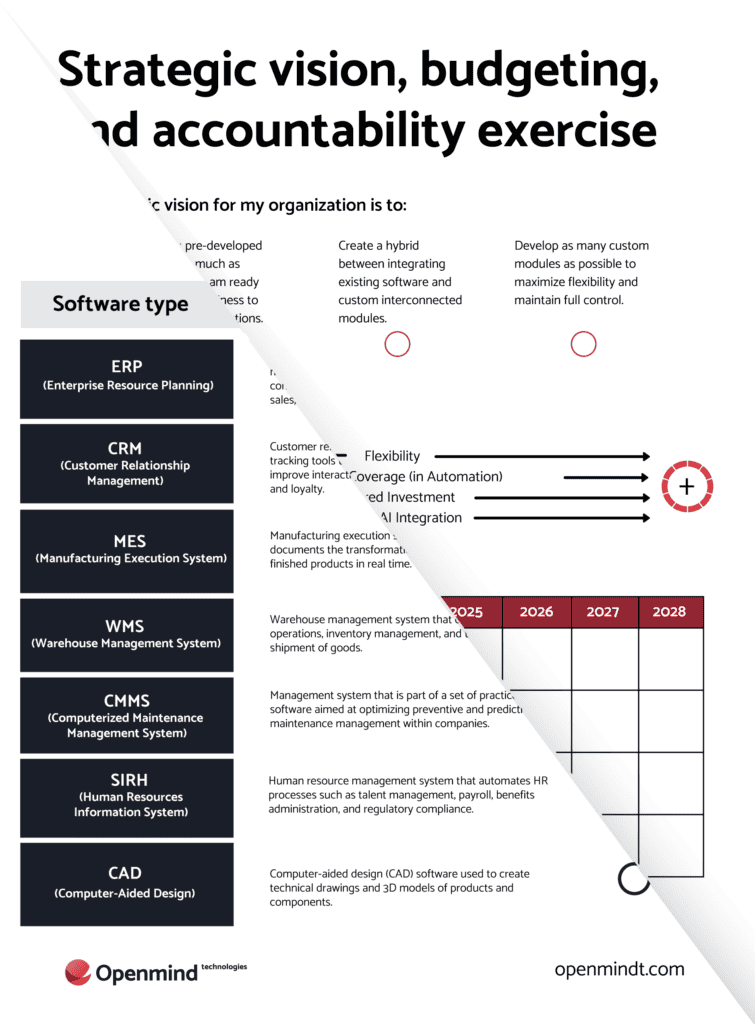Elevate your manufacturing strategy with key resources
Download our Technological Maturity Self-Assessment & Strategic Vision Exercise tools to assess your software ecosystem profile and to plan for future growth.

Business data is the key to success for modern manufacturing companies. Because of its advanced integration with machines on production lines, the M.E.S. is particularly suited to the collection and processing of this type of data. However, these only have value once they are properly processed and analyzed. This is where the use of KPIs becomes relevant.
Key performance indicators, or KPIs, are a reflection of a company’s performance and efficiency. They serve as a benchmark for measuring the performance of different processes in order to better manage and improve them.
The M.E.S. offers considerable advantages in this regard as information is available in real time, making it possible to monitor and optimize production processes.

There are six main categories of KPIs that are used in order to assess the efficiency of a manufacturing company:
If you would like to delve deeper into the subject, we invite you to consult one of our previous articles in which we discuss the different categories of KPIs in the manufacturing industry in more detail.
Having good visibility on your key performance indicators (KPI) allows you to make informed decisions to improve production processes, reduce costs and satisfy customers. In addition, a good understanding of these indicators can help you anticipate market trends and develop strategies to maintain and increase your company’s competitiveness.

Download our Technological Maturity Self-Assessment & Strategic Vision Exercise tools to assess your software ecosystem profile and to plan for future growth.


This is a ratio that distinguishes the production capacities actually mobilized for production from all the capacities potentially available over a given period. This indicator measures the efficiency and productivity of equipment by comparing their yields against their maximum potential.

Commonly called OEE, overall equipment effectiveness is defined as follows:
OEE = availability x performance x quality. Availability is shown through machine use rate, performance through efficiency rate, and quality through compliant product rate. This KPI is used to identify opportunities for improving process performance by comparing the different performances of the equipment used.

Machine downtime is a combination of scheduled downtime and unscheduled downtime. In other words, it represents all the times when a machine is unavailable for production. Considered to be one of the main reasons for lost productivity, monitoring this KPI allows you to understand the underlying reasons for these downtimes in order to take action to reduce them.

As is the case with downtime, machine setup can result in lost production time. Optimizing the configuration of machines therefore contributes to the overall efficiency of production processes.

For any business, inventory shortage or saturation are a real headache and cause many inconveniences. Ensuring an adequate inventory rotation thus becomes essential to guaranteeing production flow. This is done by managing the inventory turnover rate which is defined by the speed at which inventory is completely renewed over a given period.

This KPI, like the two that follow, is used to assess the quality of finished products, as well as the quality of production processes. First pass yield refers to the rate of products manufactured to the highest quality standards starting from the first run of the production line. Only units that do not require any alteration or repair are counted.

This KPI is used to evaluate production processes and is complementary to the First Pass Yield KPI. This indicator represents the rate of manufactured products that had to be reworked. As rework is costly in terms of resources and time, it becomes essential to reduce this rate in order to minimize production costs.

Scraps represent the rate of finished products which do not meet quality standards and which will not be marketed. It goes without saying that a high scraps rate is far from desirable. As such, minimizing this rate becomes a major challenge to reduce losses.

Respecting delivery deadlines is an important KPI to monitor. Products delivered on time reflect a well-constructed production planning that is strictly adhered to. On-time delivery demonstrate that optimal production processes are in place. Not to mention that it strengthens customer satisfaction and confidence.

No company likes defective products being returned to them. Having a system in place that tracks returns is helpful to understanding and improving failed processes.
Obviously, this list of KPIs is far from comprehensive, and it is up to each company to define the ones that are relevant to them and that will help them optimize their productivity. In the end, the KPIs chosen must be aligned with the objectives that you have set for your company.
Let’s be honest: the implementation of an M.E.S. represents a considerable investment. However, it also creates a significant return on investment when it comes to technology spending. Take the management of scraps, for example. If investing in this type of system allows you to reduce your losses and significantly increase your productivity, this expense very quickly becomes profitable. So the question that should be asked is: “Can you afford not to invest in an M.E.S.?”
While this article focuses on the Key Performance Indicators (KPIs) that can be monitored using a Manufacturing Execution System (MES), it’s also important to understand how MES differs from other systems, particularly Enterprise Resource Planning (ERP) systems. For a comprehensive comparison, you can read our detailed article on The Differences Between an ERP and an MES.
Understanding the distinctions between these two systems can help you better decide which solution is most suited to meet your manufacturing needs and how they can complement each other to optimize your operations.
Subscribe to receive our exclusive updates directly to your email.

Tell us more about your needs so that we can better route your project to our specific SWAT team.
1
During the brainstorming phase, we work with you to identify potential solutions to your business challenges to generate the technology response that aligns with your business objectives.
2
Through our requirements gathering process, we work closely with you to define and prioritize your needs, ensuring that our solutions are tailored to meet your specific requirements.
3
This phase marks the beginning of our partnership. We’ll finalize the project plan and establish clear communication channels to ensure a smooth and successful project execution.